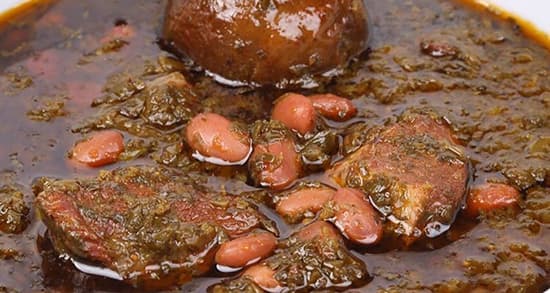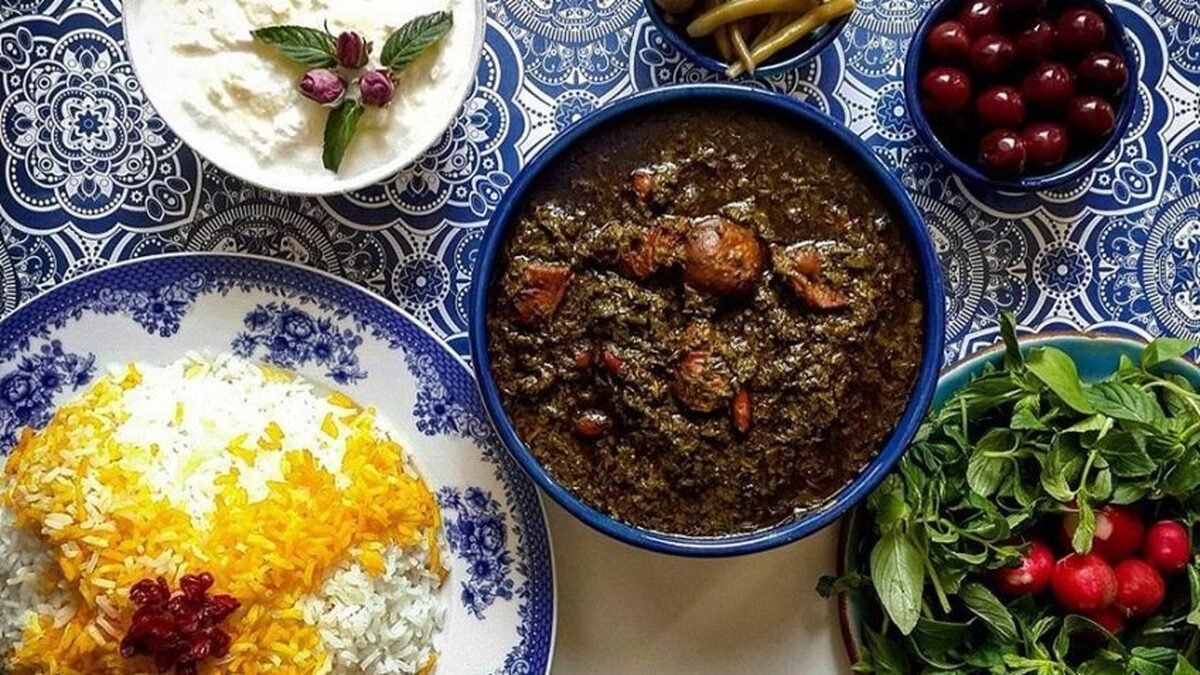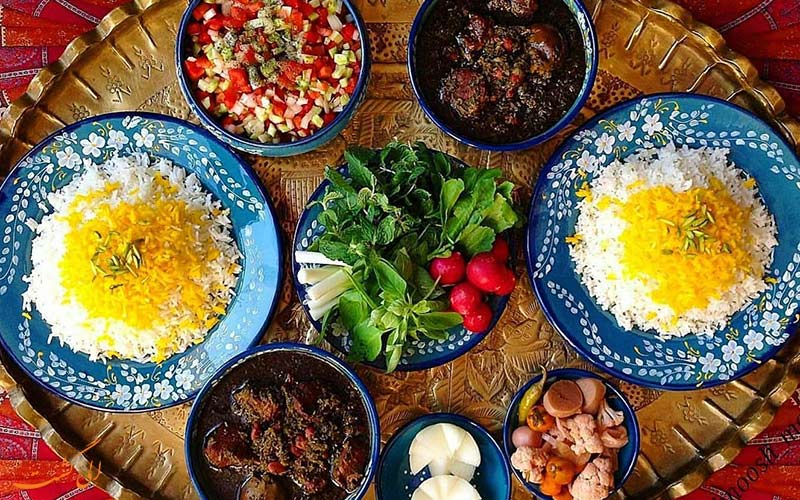ghorme sabzi | One of the most popular Iranian foods
If you travel to Iran, be sure to try homemade Ghormeh Sabzi. Ghormeh Sabzi is one of the delicious and tasty Iranian dishes. Even if you haven’t traveled to Iran, make sure to visit to experience the unique and delicious taste of this dish. Make every effort to try this Ghormeh Sabzi at home because the homemade version is much more delicious than the ones available in restaurants.In this section, we aim to provide more information about Ghormeh Sabzi, from its cooking instructions to its history and valuable cooking tips.
What is Ghormeh Sabzi?
Ghormeh Sabzi is a quintessentially Iranian dish with its origins tracing back to Tehran. It’s a dish commonly served at both formal and informal gatherings, cherished by Tehranis and Iranians alike as one of their favorite dishes. Ghormeh Sabzi consists of a special blend of herbs, lamb or beef, and traditional Iranian spices, typically served with rice, although some prefer it with bread.

Iranian Ghormeh Sabzi Recipe
The preparation of this delicious dish is relatively simple but requires attention to detail. By following the golden cooking tips, you can prepare an authentic Iranian Ghormeh Sabzi. Here’s what you’ll need:
Ingredients:
500g lamb or beef
500g chopped Ghormeh Sabzi herbs (a mixture of parsley, cilantro, fenugreek leaves)
1 cup red kidney beans
5 dried Persian limes (limoo amani)
Cooking oil
1 medium onion
½ teaspoon ground black pepper
1 teaspoon turmeric powder
1 tablespoon dried fenugreek leaves (shanbalileh)
Salt to taste
Rice
Saffron
Cooking Instructions:
Grate or finely chop the onion. Sauté it in cooking oil with turmeric and black pepper until golden.
Add the meat to the onion mixture and sauté until lightly browned.
Add the Ghormeh Sabzi herbs and kidney beans to the pot, followed by two cups of boiling water. Let it simmer for 4 to 5 hours until fully cooked.
In the last hour of cooking, add the dried Persian limes to the pot.
Half an hour before finishing, if the meat is cooked, add salt, dried fenugreek leaves, and a pinch of saffron to enhance the flavor.
Rice Cooking Instructions:
Soak the rice in salted water for two hours prior to cooking.
Boil water in a suitable pot, then add the soaked rice. Allow it to cook until partially tender.
Strain the rice and rinse it with warm water to remove excess salt.
Return the rice to the pot and steam it for another 2 to 3 hours until fully cooked. Steaming rice requires adding a little water to the bottom of the pot, covering it with a lid, and reducing the heat to a minimum.
By following these instructions meticulously, you’ll savor the authentic taste of Iranian Ghormeh Sabzi, a dish deeply rooted in Persian culinary tradition.
Ghormeh Sabzi History
The History of Ghormeh Sabzi in Iran dates back to 2000 to 5000 years ago. In other words, Ghormeh Sabzi stew is considered our national dish as Iranians. However, in different cities of beautiful Iran, slight variations in the combination of ingredients used in cooking this national stew show up. But this subtle difference in the essence of the dish does not alter. Nevertheless, what matters more than anything else is that Ghormeh Sabzi, being an Iranian national dish and enjoying global fame, is beloved among all the people of this land and is a dish that finds its place on every Iranian table and is cooked in every city and region. It seems that the beloved Ghormeh Sabzi stew can be considered not only as a national dish but also as a symbol of unity and national solidarity among Iranians.
In historical sources, Ghormeh Sabzi, a dish made from meat and various greens, has been mentioned as one of the main and beloved Iranian stews. What’s particularly interesting is that Nader Mirza Qajar, the descendant of Fath-Ali Shah Qajar, wrote in his book “Iranian Cuisine,” which is dedicated to Qajar-era cooking, about Ghormeh Sabzi: “This stew was sung by the lady of the house [referring to his wife], as a memento of the ancient Persian kings and heroes. It was the first dish they made, except that Ghormeh is a Turkish word, meaning ‘stew,’ and in Persian, it’s called ‘sabzi stew,’ which is now referred to as Ghormeh Sabzi everywhere. The lady says, ‘I cook this stew in such a way that it is more delicious than anything else in the world.'”

A fascinating aspect of Ghormeh Sabzi is that “this dish has been able to meet all needs and tastes throughout historical periods, and the delicate flexibility it has shown has had the power to unite people from all cities in different time periods and proclaim, ‘We are all Iranians.'”
The Evolution of Ghormeh Sabzi through Time and Place!
Regarding the history of Ghormeh Sabzi, the first point is that in the past, it was a seasonal dish for spring and summer; “Ghormeh Sabzi was only cooked in spring and warm seasons when greens were abundant, and unlike today, it was not a four-season dish.” Furthermore, “This dish is composed of the combination of two words, ‘ghormeh’ and ‘sabzi.’ Ghormeh in Turkish means minced meat, but in culinary art, it is a cooking method used for preserving meat and is the invention of nomads.
Iranian nomads used to roast meat in their own fat to preserve it for consumption until the next year, then they would put it in a pot or a skin bag and, figuratively speaking, ‘ghormeh’ the meat. This ghormeh alone is a delicious dish, but it has been combined with various ingredients in different seasons to create unique flavors…
Finally, the combination of slightly dried minced meat with fresh greens, water, and beans has created one of the most exquisite tastes in the world.”
An important point about the evolution of Ghormeh Sabzi is that “the transformation of Ghormeh Sabzi into what we eat today has occurred over time and with the rotation of this dish in different regions. Right now, if you travel to different cities in Iran, you will encounter foods that bear a great resemblance to Ghormeh Sabzi, but they are not what we mean by Ghormeh Sabzi today. For example, in some cities like Mashhad and Hamedan, we have a dish called ‘Abgousht Ghormeh Sabzi,’ where it seems they have increased the liquid in Ghormeh Sabzi so that in the absence of rice, one can crumble bread into it and eat it as a bread-based dish…
Today, the primary ingredients of this stew are available everywhere and every season, and the only difference in this dish in different cities is the type of beans used or the addition or subtraction of one or two types of greens… For example, in the Azerbaijani style, they use chickpeas, and in addition to common greens, they also add coriander and beet leaves or spinach.”
Tips for Cooking Delicious Ghormeh Sabzi
1.To prevent Ghormeh Sabzi from being bloated due to the use of beans, you can soak the beans overnight and change the water several times until they are completely soaked.
2.Choosing between red and brown beans depends on your taste preference. Some people prefer Ghormeh Sabzi with red beans, while others prefer it with brown beans. In some regions of Iran, people even use “cheshm bolboli” beans to prepare Ghormeh Sabzi.
3.When choosing the type of meat, it’s better to use lamb or veal with a bit of fat content for a tastier outcome.
4.Try to use less oil for frying and sautéing.
5.You can use animal fat for cooking Ghormeh Sabzi.
6.If you notice that the dish hasn’t absorbed enough oil and doesn’t have a glossy surface when serving, add 3 or 4 small ice cubes to it 10 minutes before removing it from heat. This will help the dish absorb the oil and become glossy on the surface.
7.Regarding the herbs, you can fry them before adding them to the dish based on your taste or experience. This is entirely a matter of preference.
8.You can also use saffron extract to enhance the flavor and richness of your Ghormeh Sabzi.
9.The herbs should be well-fried and nicely browned. Avoid over-browning them, as it can make the dish bitter.
10.Ghormeh Sabzi, alongside Tahchin Morgh (layered chicken and rice dish) and Kubideh Kebab (minced meat kebab), is among the traditional ceremonial dishes.
11.You can enhance the aroma and flavor of rice by adding saffron to the steaming process.
12.After soaking the beans, you can boil them for twenty minutes before adding them to the Ghormeh Sabzi, then drain the water and add them to the stew.
13.Persian limes might be bitter. To reduce their bitterness, you can pierce them with a fork and soak them in water for two to three hours.
14.The herbs for the stew include parsley, cilantro, fenugreek leaves, dried fenugreek leaves, and mint. They should be washed and chopped before being fried until their color changes.
15.To simmer rice and prepare it properly, it’s essential to learn important tips for cooking rice so that you can make perfectly cooked rice without it becoming sticky.
If you’re in Iran and craving delicious Ghormeh Sabzi, you can contact the number below to enjoy one of the best Ghormeh Sabzi dishes in Iran.
Contact Number:
+989360633960

What is ghormeh sabzi made of?
- Herbs: A mixture of parsley, cilantro, and fenugreek leaves (shambalileh), which are finely chopped and then sautéed until fragrant. Sometimes, leek or green onions are added as well.
- Lamb or Beef: Cubes of lamb or beef are typically used, although lamb is more traditional. The meat is stewed until tender.
- Red Kidney Beans: These are cooked separately and then added to the stew.
- Dried Limes (Limoo Amani): These give the dish its distinctive tangy flavor. The dried limes are punctured to release their flavor into the stew.
- Onions: Finely chopped onions are sautéed and used as a base for the stew.
- Turmeric: This is the primary spice used in Ghormeh Sabzi, adding warmth and depth to the flavor.
- Oil: Typically used for sautéing the herbs and onions.
The dish is slow-cooked to allow the flavors to meld together, and it is traditionally served over Persian rice (Chelow). The combination of the herbs, meat, beans, and the unique flavor of dried limes makes Ghormeh Sabzi a beloved and hearty dish in Persian cuisine.







